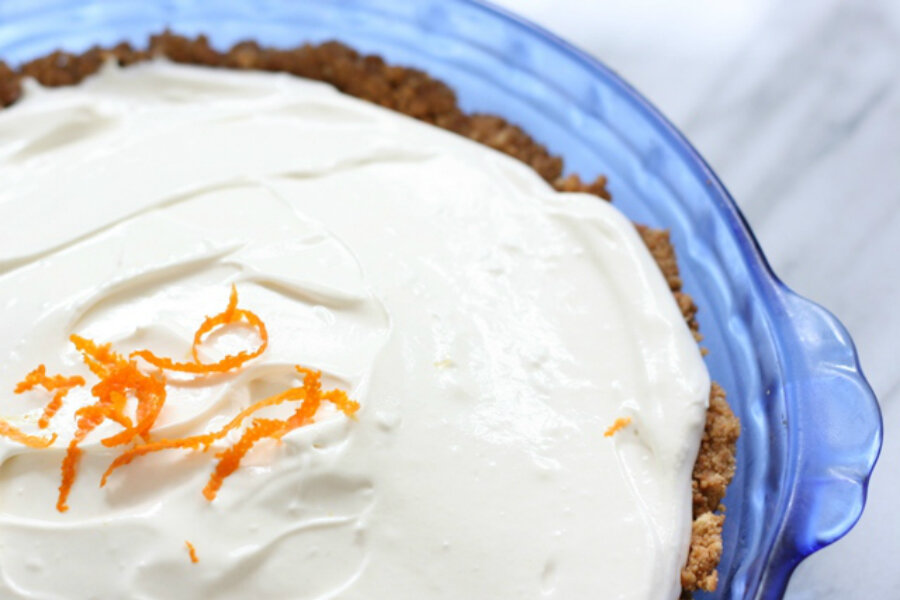No-bake citrus cloud pie
Loading...
Some grandmas send their grandchildren books. Some send LEGO’s. Others send perhaps a hand-knitted hat or hand-sewn dress.
My mom sent my son Marie biscuits. And not just a couple of packages, but 10 of them.
Granted my 5 year-old loves these biscuits (cookies, to Americans) – he can devour five or six at a single go – and they’re not easy to find stateside, the little guy was a little disappointed not to find a toy in the box.
It’s been a few months now and our stash has been steadily dwindling (we’re down to 3!), but I’m still trying to find ways to use them up.
Then, I was inspired by my friend Betty Anne’s no-bake calamansi pie. The no-bake pie idea appealed to me because it was super easy, and who doesn’t love a no-bake recipe especially in summer! Using her recipe as a jumping-off point, I came up with my own recipe using crushed Marie biscuits instead of graham crackers for the crust.
If you’re wondering, calamansi is the beloved Filipino lime that’s used extensively in Pinoy cooking and baking. In fact, limes are prolific in cuisines across Southeast Asia – the juice, rind and leaves are all important flavoring components.
Even in all my years of cooking, I still tend to get my limes mixed up, so I came up with a little primer:
1. Calamansi/Kalamansi (other names: limau kasturi, jeruk kesturi, calamondin, Chinese orange)
Scientific name: Citrofortunella microcarpa or Citrofortunella mitis
Calamansi lime is thought to be a hybrid of the mandarin orange and the kumquat. It is 1-inch to 1-1/2 inches in diameter and its thin skin is green when unripe, which turns tangerine when left to ripen. It smells refreshingly sweet with a sweet-tart flavor reminiscent of a sour orange.
In Pinoy cuisine, the juice is used to season fish, poultry, and pork and popular dishes like pancit and arroz caldo (Filipino congee). The popular seasoning, toyomansi, is made by combining soy sauce and calamansi juice. Calamansi juice is also made into a refreshing drink. Elsewhere, calamansi is squeezed over sambals and grilled fish.
Meyer lemon is the closest substitute to calamansi.
2. Makrut Lime, or the lime formerly known as Kaffir (other names: Thai lime, luk makrut, jeruk purut)
Scientific name: Citrus hystrix
Just like pop-star, Prince, the lime formerly known as kaffir is going through a name change. According to The Oxford Companion to Food, the word “kaffir” is an offensive term in some cultures and recommends that the name “makrut lime” be favored over “kaffir lime.” (Read more about it here.)
Similar in size to a small Persian lime, makrut is distinguished by its rough and bumpy dark green skin. It produces a very small amount of tart, bitter juice but its fragrant rind and leaves (bai makrut) are used to flavor chicken, fish and curries (especially Thai and Lao). The fruit is almost impossible to come by in the U.S. but the double-barreled leaves (the smaller leaf is actually a petiole) are common at Asian markets in the U.S.
3. Jeruk limo (other names: djeroek limau, nasnaran mandarin)
Scientific name: Citrus amblycarpa
I’ve only seen jeruk limo used in Indonesian cooking, hence my choice of using its Indonesian name. The fruit has thick, wrinkled skin and turns from green to yellow when mature and has a strong, floral fragrance when touched or squeezed.
Several years ago, I found a shrub for sale online and shipped it to my parents (I’m not sure it’s still alive!) but I’ve not seen jeruk limo sold anywhere. My uncle in California managed to cultivate a tree in his front yard and regularly sends my mom care packages. She guards her stash stringently and uses the limes sparingly in satay, sambals, grilled fish, and to make her famous ayam panggang (grilled chicken).
An acceptable substitute would be calamansi or key lime (jeruk nipis).
4. Key Lime (other names: jeruk nipis, Mexican lime)
Scientifc name: Citrus aurantiifolia
The key lime is smaller and seedier than the Persian lime with a tart and bitter flavor. It also has a higher acidity, a stronger aroma, and a thinner rind. You probably know key lime in the pie or in drinks (there’s a reason why it’s sometimes called bartender’s lime!).
In SE Asian cuisine, key lime is squeezed over noodle dishes like mee siam (rice vermicelli in sour tamarind soup) or bakmi (fried noodles) and used in sambals, too.
You'll find endless variations of this no-bake lemon pie. What makes my recipe distinct is the calamansi juice as well as the Marie biscuit crust. While the fruit may be hard to find (unless you're in California), you can usually find calamansi juice in sachets or bottles at Asian markets. Check the frozen section. Substitute with juice from 3 Meyer lemons if you can't find it. And of course, if you don't have a stash of Marie biscuits like I do, use graham crakers, shortbread, or digestives.
No-Bake Calamansi Cloud Pie with Marie Biscuit Crust
Serves 8
For the crust:
20 Marie Biscuits (or 1-1/2 cups crushed biscuits of your choice)
6 tablespoons butter, softened
1. Place the biscuits in a zip-top bag and seal. Crush with a rolling pin until the biscuits resemble sand.
2. Use your hands to mix the crushed biscuits with the butter in a medium bowl. Press into the bottom and up the sides of a well-greased 9-inch pie plate. Refrigerate while you make the filling.
For the filling:
1 (14 oz.) can sweetened condensed milk
1/2 cup calamansi juice (or juice from 3 medium lemons)
2 cups frozen whipped topping, thawed
1. Beat the sweetened condensed milk and calamansi juice in a medium bowl until combined. Gently fold in the whipped topping. Scoop into the crust and smooth the top down with your spatula.
2. Cover and refrigerate for 2 hours or until set.
Related post on Pickles and Tea: Piña Colada Kulfi Pops








